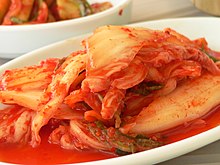The prevalence of stalls selling Hainanese chicken rice as their primary specialty in Singapore underscores the dish's unrivalled popularity amongst Singaporeans and overseas visitors. Hainanese chicken rice is considered as one of the "national dish" of Singapore, and is often served at international expositions and global events abroad, and in Singaporean-run restaurants overseas. Hainanese chicken rice is also one of the few local dishes served on Singapore Airlines flights. It is listed at number 45 on World's 50 most delicious foods complied by CNN Go in 2011.
In Singapore, Hainanese chicken rice is served everywhere from school canteens, hawker stalls to major restaurants. . There are Hainanese chicken rice stalls that have established franchise or branch outlets, and these include Five Star Hainanese Chicken Rice, Boon Tong Kee, Loy Kee, Wee Nam Kee and others which have many outlets island wide. It is very common to find Rice Balls in such chain eateries. The price range is around S$2.50-4.50 (the latter if the dish includes a drumstick). Most stalls serve extras such as braised dark soy hard boiled egg, chicken liver, braised dark soy firm tofu (Tau-kwa) and kai-lan with oyster sauce as side dishes and a bowl of plain chicken stock soup. The choice of white (steamed) or roasted chicken is commonly available at almost all eateries.
Hainanese-owned coffee shops tend to serve a variety of Hainanese cuisine, with chicken rice being the main highlight. Other Hainanese dishes include pork chop, vegetables, fish, eggs and char siew. Most of these shops are air-conditioned, and are mainly concentrated at Purvis Street and Seah Street. The dish was popularised in Singapore in the 1950s by Moh Lee Twee, whose Swee Kee Chicken Rice
ingredients
Chile Sauce:
2 to 3 tablespoons freshly squeezed lemon juice
2 tablespoons chopped fresh red chiles
5 cloves garlic, chopped
Salt
Chicken and Rice:
1 (2-pound) chicken
1 scallion, cut into 1-inch pieces
4 slices fresh, peeled ginger
6 tablespoon vegetable oil or olive oil
6 to 8 cloves garlic, finely chopped
4 cups long-grain uncooked rice
1 teaspoon fine salt
Directions
Make the Chile Sauce: Combine all the ingredients in a bowl, mix well, and season with salt, to taste. Set aside
Make the Chicken and Rice: Bring a large pot of salted water to a boil (enough water to immerse the chicken). Stuff the cavity of the chicken with the scallion and ginger. Add the chicken to the boiling water, breast side-down. Lower the heat to a simmer just under boiling point and cook, covered, until just cooked through, about 40 minutes.
Transfer the chicken to an ice water bath for about 5 to 6 minutes. (This is to arrest the cooking and will make the chicken skin crisp.) Drain. De-bone the chicken and cut into bite-sized pieces. Reserve the chicken stock, and keep hot.
Heat the oil in a wok or saucepan over high heat. Add the garlic and stir-fry until fragrant. Add the rice and stir-fry for 1 to 2 minutes. Add enough of the hot reserved chicken soup to reach 1/2- inch above the top of the rice. Bring to the boil, add the salt, and lower the heat to low. When steam holes form in the rice, cover the wok, and steam until cooked, about 30 minutes.
Whisk 1/4 cup of the hot chicken stock into the chile sauce.
Arrange the rice and poached chicken on a platter and drizzle with the chile sauce.






